TIA published the best analysis of the Knock Apparition ever done KNOCK LINKIt includes written eye witness testimony. The conclusion is that main theme of Knock was that by 1879, the voice of the Catholic Church had been muzzled.Reflections on Knock - I
The Message of Our Lady of Knock: The Silence Veils a SecretGregory Johnson
One rainy night on the 21st of August 1879, from around 7:15 to 9:30 in a small village of no more than a dozen homes, Our Lady made a unique, silent public appearance that has become known to the world as the apparition of Our Lady of Knock.
The village of Knock (which means ‘hill’ in Irish) lies in the northwest quadrant of Ireland, about 28 miles east of
Croagh-Patrick, and this prophetic mountain can be seen to the west on the road north from Claremorris to Knock. (1) The pilgrimages to the shrine in the little village have steadily grown since that day, and it presently receives 1.5 million visitors a year. In 1932, Pius XI declared Our Lady of Knock to be “Queen of Heaven and of Ireland” at the closing of the Eucharistic Congress. (2) It is considered to be one of the prominent Marian Shrines of the world.
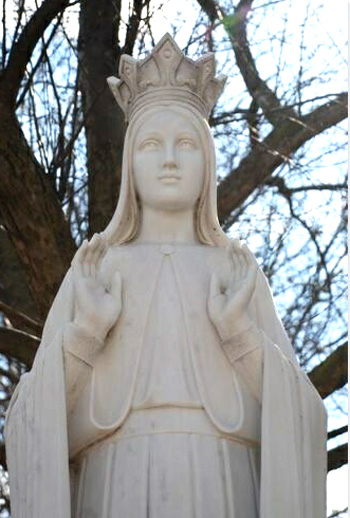
Our Lady of Knock
I say Our Lady made a “public appearance” because, unlike other recent apparitions of Our Lady - La Salette, Lourdes, Fatima - where she appears and communicates to only one or a few seers (always youths and never members of the clergy), in this apparition she appeared to all present but remained silent. Everyone at or near the south gabled wall of the church dedicated to St. John the Baptist saw the apparition.
The only member of the clergy in the village, the pastor
Archdeacon Cavanagh, could also have seen the apparition if he had simply stepped outside. His housekeeper went to tell him about it, but apparently there was some miscommunication and, as a result, once again, the clergy did not receive the gift of seeing an apparition of Our Lady.
Shortly after the apparition, an official commission of investigation was set by the Archbishop, and it recorded the testimony of 15 witnesses: men, women and children, ranging in ages from 5 to 75. At the inquiry, the commission found that, “the testimony of all, taken as a whole, was trustworthy and satisfactory.” (3). Many years later, in 1936, a second commission confirmed the verdict of the first.
Mary Byrne, a primary witness of the apparition at Knock, was 86 at the time of the second commission and spoke to the commission from her bed since she was too sick to leave. She concluded her testimony with these words, “I am clear about everything I have said and I make this statement knowing I am going before my God.” Six weeks later she died. (4)
There were others who saw the apparition (my readings suggest somewhere between 25 and 29 people), whose reports were not officially recorded to avoid redundancy.
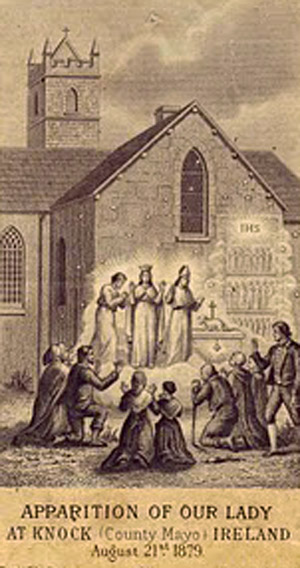
A depiction of the apparition from an old holycard
Below is the testimony of Judith Campbell, one of the 15 official witnesses of the apparition. It is short and concise:
I live at Knock; I remember the evening and night of the 21st August last.
Mary Byrne called at my house about eight o’clock on that evening, and asked me to come and see the great sight at the chapel.
I ran up with her to the place, and I saw outside the chapel, at the gable of the sacristy facing the south, three figures representing St. Joseph, St. John and the Blessed Virgin Mary; also an altar, and the likeness of a lamb on it, with a cross at the back of the lamb.
I saw a most beautiful crown on the brow or head of the Blessed Virgin. Our Lady was in the centre of the group, a small height above the other two; St. Joseph to her right, and bent towards the Virgin; St. John, as we were led to call the third figure, was to the left of the Virgin, and in his left hand he held a book; his right hand was raised with the first and second fingers closed, and the forefinger and middle finger extended as if he were teaching.
The night came on, and it was very wet and dark.
There was a beautiful light shining around the figures or likenesses that we saw.
I went within a foot of them; none of us spoke to them; we believed they were St. Joseph and St. John the Evangelist, because some years ago, statues of St. Joseph and the Evangelist were in the chapel at Knock.
All the figures were in white or in a robe of silver-like whiteness; St. John wore a small mitre. Though it was raining, the place in which the figures appeared was quite dry.
Everything within the sphere of the image remained completely dry including the grass and part of the church wall.
The deliberate silence
The apparition was completely silent. The only sounds heard that night were those of the wind and the ever-increasing rain, which eventually became a downpour. But we know that the actions of Divine Providence must always have an ordered purpose. As Fr. William J. Smith said, “There was no message of any kind given, no word was uttered by any of the three celestial visitors. Yet the apparition must have a meaning, an extraordinary, deep and divine significance” (5)
Consequently, no one should think that the silence of the apparition is an oversight of Our Lady. With certainty, we can affirm that Our Lady willed that this apparition should remain completely silent and that this silence serves a purpose. What is that purpose?
We know that all of the recent apparitions of Our Lady, both before and after Knock, contained secrets:
- La Salette (1846) contained secrets such as ‘Rome will become the seat of the Antichrist” that could be revealed in 1858;
- Lourdes (1858) had 3 secrets that were for Bernadette alone and were never revealed;
- Fatima (1917) included 3 secrets: 2 were soon revealed, and the third was to be revealed in the event of Lucia’s death or by 1960. John XXIII refused to reveal the secret in 1960. Later in 2000, a bogus secret was revealed by Cardinals Bertone and Ratzinger on behalf of John Paul II, but it did not find great acceptance among the faithful. They still await the release of the authentic warning of Our Lady to the world.
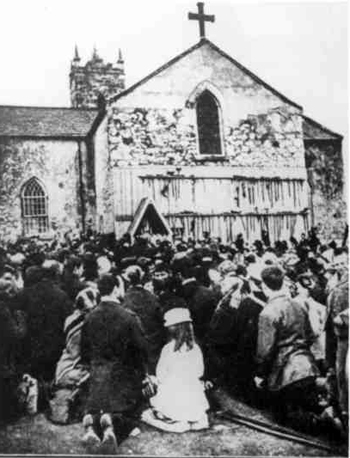
Pilgrims in the 1880s flocking to the apparition site outside the old chapel at Knock
Now, since every recent apparition of Our Lady contained a secret, one is induced to ask whether or not there would be a secret at Knock. Perhaps it should even be expected.
So, I ask, shouldn’t this deliberate silence willed by Our Lady at Knock be seen as some form of secret? A secret that harmonizes with the secrets of La Salette, Lourdes, and Fatima? Isn’t it reasonable to affirm this?
Shouldn’t one ask if the silence acted as a sort of veil or shroud, concealing a profound message? I believe this is the deep-seated purpose of the silence and suggest to speculate upon what that secret would be using the evidence that we have at hand.
One closing note: I do not agree with those who say that the silence itself is the message. The message of Our Lady of Knock is not to promote silence.
Those who try to present this silence as the main message that Our Lady wished to convey are promoting a passivity that pressures the faithful to remain inactive and just pray in face of the grave crises in the Church and society we face today. To keep silent before the onslaughts of an evil world and a corrupt Hierarchy is to suppress the Catholic militant spirit.
As will be shown in future articles, I believe that the message of Knock is the opposite of a lifestyle of “peace” where “all my cares and troubles cease,”(6) a phrase from the chorus of the popular Lady of Knock song that has effectively become the modern day theme song of Our Lady of Knock.
Our Lady of Knock, pray for us.
Reflections on Knock - II
Our Lady of Knock & the Apparition at La SaletteGregory Johnson
In my
first article, the apparition of Our Lady of Knock (1879) was introduced to the readers. I pointed out that, as in the other three recent major apparitions – La Salette (1846), Lourdes (1858), and Fatima (1917) – Our Lady did not appear to the clergy. There were secrets in these three apparitions; in the case of Knock the secret is veiled in the silence of the apparition. I also presented the testimony of one of the official 15 witnesses at Knock. I plan to continue the analysis of those testimonies in the succeeding articles.
The apparition at Knock, because of the absence of a spoken or written message, is usually set aside and considered less important than La Salette, Lourdes or Fatima. But I believe that, for those who have eyes to see, Knock is as important as the other three apparitions and should be considered as one of the four major apparitions of recent history. Today I will compare the apparition of Our Lady of Knock with that of Our Lady of La Salette.
Apparition of Our Lady of La Salette
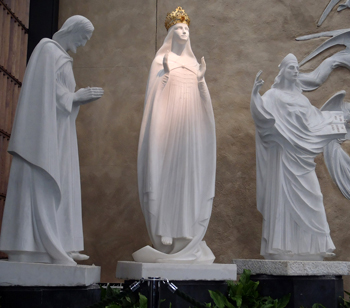
Our Lady of Knock with a solemn St. Joseph & St. John pointing to the Apocalypse
On a lone mountainside near La Salette, France, on the eve of Our Lady of Sorrows, during the month of the Holy Cross, on the beautiful day of September 19, 1846, Our Lady appeared to two peasant shepherd children named Melanie Calvat and Maximin Giraud. She wept almost for the duration of the apparition, sometimes burying her tear-covered face in her own hands. Melanie would lament that she could not console the beautiful Lady.
In this apparition the Mother of God spoke to the children, asking prayers and penance to help her prevent the arm of her Son from falling over mankind for their sins. She also gave secrets to each of the children. Twice, toward the end of this apparition, Our Lady said, “Well, my children, you will make this known to all my people.”
Here are some of the words she spoke that are part of those secrets she gave to the children to spread:
- Rome will lose the faith and become the seat of the Antichrist;
- Woe to the Princes of the Church who will not be occupied except to pile up riches upon riches, to safeguard their authority and to dominate with pride;
- The priests, ministers of my Son, by their wicked lives, their irreverence and their impiety in the celebration of the Holy Mysteries, by their love of money, their love of honors and pleasures, the priests have become cesspools of impurity;
- The Church will have a frightful crisis;
- Many convents are no longer houses of God, but the pastures of Asmodeas [the Devil of impurity] and his sort;
- The Church will be in eclipse, the world will be in dismay.
Knock & La Salette: affinities & contrasts
As for the affinities, when we compare Knock and La Salette one notices that, besides the presence of secrets and the absence of any clergy, there is another common trait: Our Lady is not appearing inside any Church structure.
The four recent apparitions do not take place inside a church, a convent, a monastery or the like. The apparition of La Salette is on a mountainside, Lourdes is in a grotto, Knock is deliberately and conspicuously just outside of a church that is a few feet away, and Fatima takes place in the fields at the Cova da Iria.
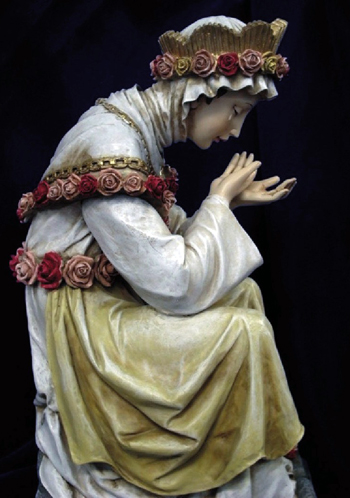
Our Lady wept almost continuously at La Salette, but also spoke to the children
As with Knock, Our Lady of La Salette would appear only once; at Lourdes and Fatima she appeared to the seers multiple times.
Also, as with Knock, the color of Our Lady of La Salette’s clothing was described as something like a silvery white and she appeared in a brilliant sphere of light that did not harm the eyes. She was “clothed with the sun.”
Both Knock and La Salette had been suffering from potato famines that Our Lady at La Salette said was a consequence of man’s sins, especially the profanation of her Son’s name and not keeping holy Sunday, the Lord’s day.
As for the contrasts, at Knock not once would Our Lady look down at the people watching before her or change her expression, and that evening the only tears were those from the sky, rain. In fact, in some ways, the contrast between the two apparitions could not have been greater.
At La Salette (1846), it was a beautiful sunny day in the French Alps, but Our Lady was constantly weeping. Thirty three years later at Knock, it was the opposite. It was an ominously dark, rainy and gloomy day, but Our Lady shed no tears within a bright, dry, splendorous sphere of light. The witnesses saw in her eyes only the fixed, resolute gaze upward of one in a state of profound prayer.
Of course, there is also the obvious contrast between the spoken message of La Salette and the silent message of Knock. I have already mentioned that I believe the silence at Knock could be seen as a form of secret. One could also ask whether or not the silence of the Knock apparition is a consequence of an infidelity.
Did the actions of a person or persons, especially if they are members of the Catholic Hierarchy, cause this to be a silent apparition? Did some betrayal cause Divine Providence to “say” in 1879 something analogous to what Our Lord said to the “wicked and adulterous generation” of His time: “A sign shall not be given” (Mt 16:4)?
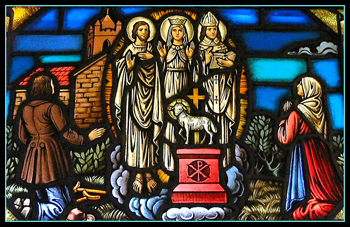
A mystery veiled in the silence and symbols of the apparition of Our Lady at Knock
It could be noted that the saintly Pope Pius IX began his reign in June 1846, just a few months before the apparition of La Salette and died in 1878, the year before the apparition at Knock. He was succeeded by the liberal pontificate of Leo XIII: the reigning Pope during the silent apparition of Our Lady of Knock.
Let me observe that during the entire pontificate of Leo XIII the true Catholics, the Ultramontanes, were obliged to be silent about those enemies – liberal Catholics – who had been condemned and removed from the scene by Pius IX. We may say that with Leo XIII the militancy of the Church was silenced, that she entered a dark, long and rainy night. Likewise, tolerance toward the errors of the Revolution was exalted, and the Revolution entered a sunny day that prepared Modernism, Progressivism and Vatican II. Doesn’t the silence of Knock have a relation to this papal silence?
Speaking of infidelity, there is another point of contrast between the two apparitions: La Salette received from the Vatican a kind of “gag order”… Knock did not. In 1915, a year after the death of Pope St. Pius X, under the more compromising reign of Pope Benedict XV, there was a decree issued from the Vatican forbidding public commentaries on the secret messages of La Salette. This decree seems to be still in effect even in the present-day scandalous reign of Francis I. We are allowed to have the text, read it and pass it on to friends. But we may not publicly comment on the secret messages of La Salette.
So, we see that a type of silence was placed upon the apparition at La Salette. Perhaps Our Lady, Queen of Prophets, had this future event in mind when she remained silent at Knock. It would be difficult, even absurd, to try to silence a silent message.
Knock & La Salette: a significant connection
At La Salette, after Our Lady said, “Well, my children, you will make this known to all my people,” she rose to leave the children, paused and looked in silence toward the southeast, toward Rome. At Knock, we see that, from the south gable, Our Lady seems once again to be looking silently toward the southeast, toward Rome - toward Rome and toward La Salette, since both lie in the same direction from Knock.
And as we shall see in the next article, on the very same day as the miraculous apparition of Our Lady of Knock, August 21, 1879, there was something very significant and important also happening in La Salette.
Our Lady of Knock, pray for us.
Our Lady of La Salette, pray for us.
Testimony of Another Witness Recorded by the Knock Commission
Dominick Byrne
I am brother of Mary Byrne, who has given her evidence already. I live near the chapel of Knock. My age is 20 years. On the occasion when my sister came at about eight o’clock on the evening of August 21 into our house, she exclaimed: “Come, Dominick, and see the image of the Blessed Virgin as she has appeared to us down at the chapel.” I said, “‘What image?” And then she told me, as she has already described it for Your Reverence in her testimony.
She told me all she was after seeing. I then went with her, and by this time some 10 or 12 people had collected around the place, namely, around the ditch or wall fronting the gable where the vision was being seen, and to the south of the schoolhouse.
Then I beheld the three likenesses or figures that have been already described – the Blessed Virgin, St. Joseph, St. John - as my sister called the Bishop, who was like one preaching, with his hands raised towards the shoulder, and the forefinger and middle finger pointedly set; the other two fingers compressed by the thumb; in his left he held a book. He was so turned that he looked half towards the altar and half towards the people. The eyes of the images could be seen; they were like figures, in as much as they did not speak I was filled with wonder at the sight I saw.
I was so affected that I shed tears. I continued looking on for fully an hour, and then I went away to visit Mrs. Campbell, who was in a dying state. When we returned the vision had disappeared. Reflections on Knock - III
Our Lady Appears at Knock During
Her Crowning at La Salette
Gregory Johnson
Thirty-three years after the Apparition of La Salette, a solemn papal canonical coronation of Our Lady took place and the Basilica of La Salette was consecrated. Three different sources report the event:
- “On 21 August 1879, Pope Leo XIII formally granted a Canonical Coronation to the image at the Basilica of Our Lady of La Salette.” (1)
- “An impressive ceremony took place at La Salette, in which the statue of Our Lady was solemnly crowned by the Papal Legate, the Cardinal Archbishop of Paris, before a vast assembly of Bishops, priests and lay people.” (2)
- “In 1879, the Basilica would at last be consecrated and the statue of Our Lady of La Salette would, by the Pope’s leave, be crowned. Officiating at the consecration was the Cardinal Archbishop of Toulouse, and the coronation was carried out by the Cardinal Archbishop of Paris, acting as papal delegate for this rite. Bishops and Archbishops in numbers were on hand and with them came pilgrims from every diocese (3)
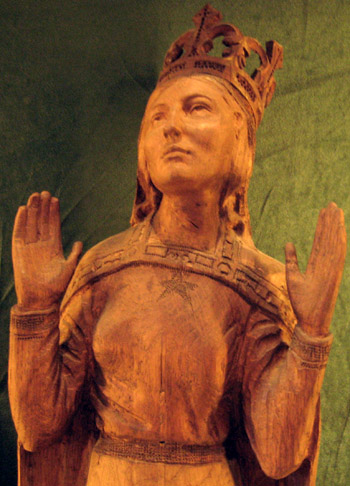
Our Lady of Knock appeared in a position of silent plea
On that same day, a day that must be acknowledged as the public and official recognition by the Church of the apparition of La Salette, the Mother of God was also appearing in the
little village of Knock, Ireland. In other words, on August 21, 1879, we have Our Lady of Knock gazing in the direction of La Salette and Rome on the exact day, perhaps even the same hour, as the ceremonies recognizing the Apparition of La Salette were occurring.
If we are looking for messages and meanings in the silent apparition of Knock, here I believe Our Lady could not be clearer. Her appearing on that specific day means she is making a connection with La Salette and its message. She is letting us know that the apparition at Knock must be seen in light of the dire message sent at La Salette.
By appearing precisely on that day, she is signifying that the Knock apparition should be seen as part or a development of the La Salette apparition. I see no other possible conclusion. Authentic apparitions of Our Lady are far too rare for this to be a mere coincidence of dates.
It is interesting to note that the precise times of the beginning and the end of the Knock apparition are unknown. As can be read in the testimony of Margaret Byrne, below, the apparition began before anyone was there to see it.
By all accounts, Our Lady was appearing before anyone arrived; she remained while people were coming and going, and she stayed even after everyone had left. Actually, in a house neighboring the site where the apparition took place, a lady named Mrs. Campbell was dying, and during the apparition someone shouted for help from her house. The village people who were still viewing the apparition ran to help the dying lady; when they returned the apparition was gone.
In other apparitions, Our Lady seems to arrive only when there are witnesses, who also watch her leave. In this case, it was the opposite; Our Lady arrived before the witnesses and remained even after the viewers left.
One possible message that Our Lady might be sending is that the time and duration of the appearance of Our Lady at Knock was not dependent on the presence or absence of witnesses, but on what was happening at that time with the ceremonies of La Salette.
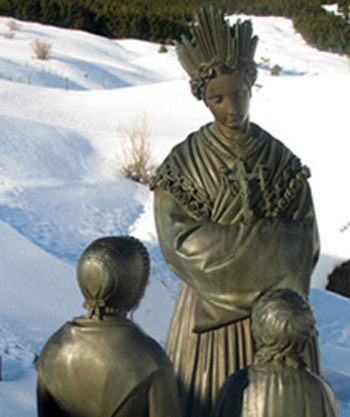
Our Lady of La Salette appeared to the children and spoke her dire warnings
If we try to find a complement for the message of La Salette in the silent symbolism of Knock, we see that the crisis in the Church prophesized in La Salette are confirmed by the presence of St. John, who appeared as a Bishop with a book – probably the Apocalypse – in his hand. This is tantamount to him saying: “The crisis that Our Lady predicted in La Salette, which will make Rome become the seat of the Antichrist and will represent the eclipse of the Church, I also prophesized in the Apocalypse.”
So, we should understand the crisis as something permitted by God for His final victory and greater glory. For the glory of the Lamb of God, which also appears luminous over the altar in Knock as well as in the Apocalypse. It is something that invites us not to despair, but to trust Our Lady and Our Lord.
Also the presence of St. Joseph, Protector of the Church, in the Knock apparition sends the message: “No matter how grave the crisis may be, I will continue to protect the Church and lead her to a safe port as I did with the Holy Family. You, the faithful, must have recourse to me and my Most Holy Spouse, the Virgin Mary, in this crisis.” Again, the message is to increase our confidence in the supernatural.
I believe that these points are valid developments of the message of La Salette, which we must take into consideration given that Our Lady chose to appear in Knock on the precise same day when her apparition of La Salette was being officially recognized by the Church.
Our Lady of Knock, Pray for Us.
Our Lady of La Salette, Pray for Us
Testimony of Margaret Byrne, Witness before the Knock Commission
I, Margaret Byrne, live near Knock chapel. I am sister to Mary Byrne, who has seen the vision. I remember the night of 21 of August, I left my house at half-past seven o’clock, and went to the chapel and locked it. I came out to return home. I saw something luminous or bright at the south gable, but it never entered my head that it was necessary to see or inquire what it was. I passed by and went home.
Shortly after, about eight o’clock, my niece, Catherine Murray, called me out to see the Blessed Virgin and the other saints that were standing at the south gable of the chapel. I went out then and ran up to see what was to be seen.
I there beheld the Blessed Virgin with a bright crown on her head, and St. Joseph to her right, his head inclined a little towards Our Blessed Lady, and St. John the Evangelist to her left, eastwards, holding in his left hand a book of the Gospels, and his right hand raised the while, as if in the attitude of preaching to the people who stood before him at the ditch.
The Virgin appeared with her hands uplifted as in prayer, with eyes turned towards Heaven, and wearing a lustrous crown. I saw an altar there. It was surrounded with a bright light, nay, with a light at times dazzling, and so too were the other figures, who were similarly surrounded.
Continued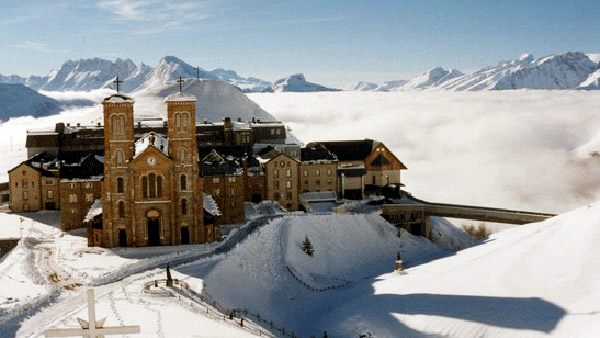
The solemn consecration of the Sanctuary of Our Lady of La Salette,
above, was made on August 21,
1879, exactly when the Knock apparition was taking place
Posted June 3, 2015
Reflections on Knock - IV
Our Lady of Knock & Our Lady of Lourdes
Gregory Johnson
Some aspects of the apparition of Our Lady of Knock were already analyzed in previous articles (
here,
here, and
here). Today, I will continue these ‘reflections’ by looking at other parallels, this time between Knock and the apparitions of Our Lady of Lourdes.
Our Lady’s Apparition at Lourdes
Beginning on February 11, 1858, in a grotto near Lourdes, France, Our Lady appeared 18 times until the last one on July 16, 1858 to a young peasant girl, Bernadette Soubirous, who would later be canonized. This was 12 years after Our Lady’s Apparition at La Salette and 24 years before her next apparition at Knock. As at Knock and La Salette, Our Lady at Lourdes gave secrets, did not appear to the clergy and did not appear inside any Church structure.
She appeared and spoke only to Bernadette. The message of Our Lady was one of penance and prayer. She told Bernadette to have a basilica built at that site and a miraculous spring of water appeared there, causing many cures of the sick.
Lourdes & Knock: both confirmations of papal declarations
In Rome, in 1854, Pope Pius IX declared the Dogma of the Immaculate Conception. Consequently, when Our Lady at Lourdes said, “I am the Immaculate Conception,” two things could be understood.
First, it attested to the veracity of those apparitions since the simple Bernadette knew nothing of the meaning of that theological term.
Second, it was a confirmation of that Papal dogma.
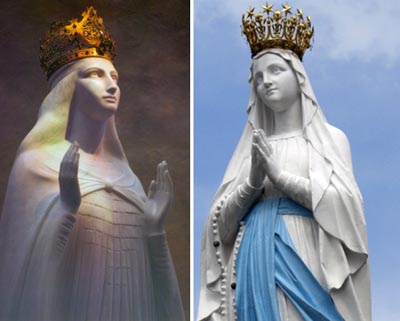
Our Lady at Knock and Lourdes: both confirm papal declarations
At Knock something analogous happened: It also confirmed a recent papal declaration, as Pius IX had publicly declared St. Joseph as Patron of the Church in 1870 in the decree
Quemadmodum Deus. Here are the reasons he gave:
“Because of this sublime dignity which God conferred on His most faithful servant, the Church has always most highly honored and praised Blessed Joseph, next to his Spouse, the Virgin Mother of God, and has besought his intercession in times of trouble.
“And now, therefore, when in these most troublesome times the Church is beset by enemies on every side, and is weighed down by calamities so heavy that ungodly men assert that the gates of Hell have at length prevailed against her, the venerable Prelates of the whole Catholic world have presented to the Sovereign Pontiff their own petitions and those of the faithful committed to their charge, praying that he would deign to constitute St. Joseph Patron of the Church. And this time their prayer and desire was renewed by them even more earnestly at the Sacred Ecuмenical Council of the Vatican.
“Accordingly, it has now pleased the Most Holy Sovereign, Pope Pius IX, in order to entrust himself and all the faithful to the Patriarch St. Joseph’s most powerful patronage, has chosen to comply with the Prelates' desire and has solemnly declared him Patron of the Catholic Church…”
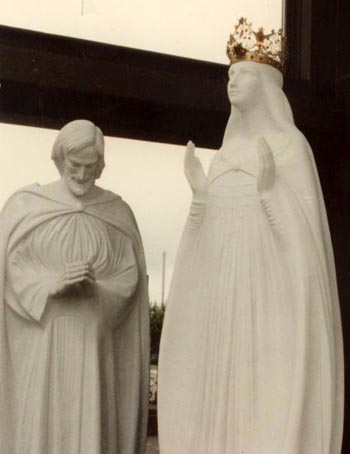
St. Joseph, head bowed, turns toward Our Lady
In 1879, nine years after this decree, St. Joseph appeared at Knock. His silent presence there was a confirmation of that papal dedication. He was present there in a position of patron and protector. By the fact that he was turned toward Our Lady with his head slightly inclined, he was telling us that “in these most troublesome times” we should turn to her. So, besides confirming the papal entrustment, he also offered us the best way to find a solution to the difficult situation in the Church.
This coming Friday, August 21, 2015, is the anniversary of the Apparition of Knock. It is also, very significantly, the eve of the Feast of the Immaculate Heart of Mary. In 1944, August 21 was named the vigil of the Feast of the Immaculate Heart of Mary. It seems that Pope Pius XII placed August 22 on the calendar as the Feast of the Immaculate Heart of Mary in response to the request of Sister Lucia of Fatima.
Today, I pause at this point and in my next article I shall continue the comparisons of Knock and Lourdes. Doing so I make this article shorter because I would like to share with my readers the wonderful testimony given below. Patrick Hill, age 14, gives one of the 15 official testimonies recorded by the Episcopal Knock Commission. It is the longest testimony and I believe the most interesting. With all the curiosity and agility of youth, he explores and describes in detail the Apparition at Knock.
May Our Lady of Knock help all of us during these “times of trouble,” on the 136th anniversary of her apparition.
Our Lady of Knock, Pray for Us;
Our Lady of Lourdes, Pray for Us.
Testimony of Patrick Hill, Witness before the Knock Commission
I am Patrick Hill; I live in Claremorris; my aunt lives at Knock; I remember the 21st August last; on that day I was drawing home turf, or peat, from the bog on an ass.
While I was at my aunt’s at about eight o’clock in the evening, Dominick Byrne came into the house. He cried out: ’Come up to the chapel and see the miraculous lights and the beautiful visions that are to be seen there.’ I followed him; another man by name Dominick Byrne, and John Durkan, and a small boy named John Curry came with me; we were all together; we ran over towards the chapel.
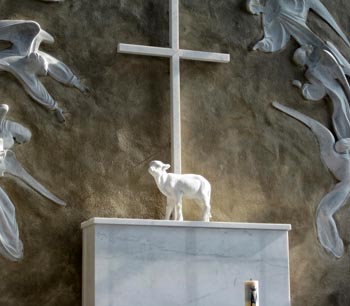
14-year-old Patrick Hill describes what he saw, including the Lamb on a stripped altar
When we, running southwest, came so far from the village that on our turning, the gable came into view, we immediately beheld the lights: a clear white light, covering most of the gable, from the ground up to the window and higher. It was a kind of changing bright light, going sometimes up high and again not so high. We saw the figures – the Blessed Virgin, St. Joseph and St. John, and an altar, with the Lamb on the altar, and a cross behind the Lamb.
At this time we reached as far as the wall fronting the gable. There were other people there before me; some of them were praying, some not. All were looking at the vision; they were leaning over the wall or ditch, with their arms resting on the top. I saw the figures and brightness; the boy John Curry, from behind the wall, could not see them, but I did; and he asked me to lift him up till he could see the grand babies, as he called the figures.
It was raining; some – amongst them Mary McLoughlin – who beheld what I now saw, had gone away; others were coming. After we prayed a while I thought it right to go across the wall and into the chapel yard. I brought little Curry with me; I went then up closer; I saw everything distinctly. The figures were full and round, as if they had a body and life; they said nothing, but as we approached, they seemed to go back a little towards the gable.
I distinctly beheld the Blessed Virgin Mary, life size, standing about two feet or so above the ground, clothed in white robes, which were fastened to the neck; her hands were raised to the height of the shoulders, as if in prayer, with the palms facing one another, but slanting inwards towards the face; the palms were not turned towards the people, but facing each other as I have described. She appeared to be praying; her eyes were turned, as I saw, towards heaven.
She wore a brilliant crown on her head and, over the forehead, where the crown fitted the brow, was a beautiful rose. The crown appeared brilliant and of a golden brightness, of a deeper hue, inclined to a mellow yellow, than the striking whiteness of the robes she wore. The upper parts of the crown appeared to be a series of sparkles, or glittering crosses.
I saw her eyes, the balls, the pupils, and the iris of each – [the boy did not know those special names of those parts of the eye, but he pointed to them, and described them in his own way].
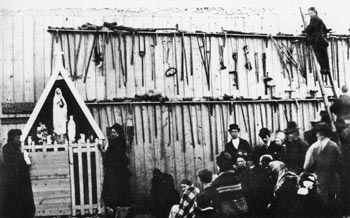
The Knock shrine around 1880, many crutches attest to cures, as at Lourdes
I noticed her hands especially and face; her appearance. The robes came only as far as the ankles; I saw the feet and the ankles; one foot, the right, was slightly in advance of the other. At times she appeared, and all the figures appeared to move out and again to go backwards. I saw them move; she did not speak. I went up very near; one old woman went up and embraced the Virgin’s feet and she found nothing in her arms or hands; they receded, she said, from her.
I saw St. Joseph to the Blessed Virgin’s right hand; his head was bent from the shoulders forward; he appeared to be paying his respects. I noticed his whiskers, they appeared slightly grey. There was a line or dark mearing between the figure of the Blessed Virgin and that of St. Joseph, so that one could know St. Joseph, and the place where his figure appeared distinctly from that of the Blessed Virgin and the spot where she stood. I saw the feet of St. Joseph, too; his hands were joined like a person at prayer.
The third figure that stood before me was that of St. John the Evangelist. He stood erect to the Gospel side of the altar and at an angle with the figure of the Blessed Virgin, so that his back was not turned to the altar nor to the Mother of God. His right arm was at an angle with a line drawn across from St. Joseph to where Our Blessed Lady appeared to be standing.
St. John was dressed like a bishop preaching; he wore a small mitre on his head. He held a Mass book, or a Book of the Gospels, in the left hand; the right hand was raised to the elevation of the head. While he kept the index finger and the middle finger of the right hand raised, the other three fingers of the same hand were shut. He appeared as if he were preaching but I heard no voice; I came so near that I looked into the book; I saw the lines and the letters. St. John wore no sandals.
His left hand was turned towards the altar that was behind him; the altar was a plain one, like any ordinary altar, without any ornaments. On the altar stood a Lamb – the size of a lamb eight weeks old; the face of the Lamb was fronting the west and looking in the direction of the Blessed Virgin and St. Joseph.
Behind the Lamb a large cross was placed erect or perpendicular on the altar. Around the Lamb I saw angels hovering during the whole time, for the space of one hour and a half or longer. I saw their wings fluttering, but I did not perceive their heads or faces, which were not turned to me.
For the space of one hour and a half we were under the pouring rain; at this time I was very wet. I noticed that the rain did not wet the figures which appeared before me, although I was wet myself; I went away then.
Patrick Hill Reflections on Knock - V
An Approaching Storm
Gregory Johnson
Continuing my series of articles on Our Lady of Knock (previous articles
here,
here,
here and
here), I remind the reader I am studying the Knock Apparition (1879) in light of Our Lady’s three other apparitions at La Salette (1846), Lourdes (1858) and Fatima (1917), with an emphasis on Lourdes. I want to show the inter-relationships among the apparitions in order to place the Knock apparition, which is often ignored, into the picture for our times.
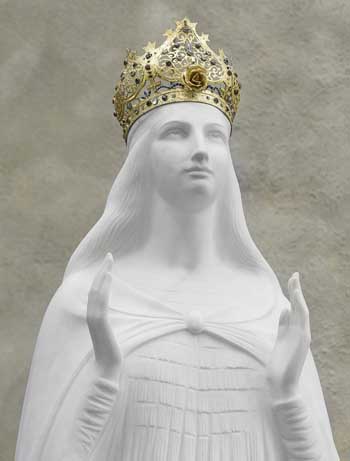
The apparitions of Our Lady of Knock, La Salette, Lourdes & Fatima are strongly linked
At La Salette Our Lady said: “Melanie, what I am going to tell you now will not always be secret. You will be allowed to publish it in 1858.” This was the year she appeared in Lourdes.
At La Salette as well as at Lourdes, a miraculous spring flowed after Our Lady’s apparition, which caused many cures.
Lourdes confirmed the dogma of the Immaculate Conception declared by Pius IX four years earlier in 1854, and Knock confirmed the act of placing the Church under the patronage and protection of St. Joseph in 1870 by Pius IX, a measure he took, he said, because of “these most troublesome times in which the Church is beset by enemies on every side.”
The dogma of Papal Infallibility was also declared in 1870. But it is especially noteworthy that the year of the apparition at Knock (1879) marks the 25th anniversary of the infallible declaration of the dogma of the Immaculate Conception.
Pope Pius IX was the reigning Pontiff during the La Salette and Lourdes apparitions, but he died the year before the silent Knock apparition.
August 21, 1879, is not only the day of the apparition of Knock, the Consecration of the Basilica of La Salette and the papal coronation of Our Lady of La Salette, but it is also the year of the completion of the Cathedral of Lourdes begun under Pius IX in 1870 with his approval.
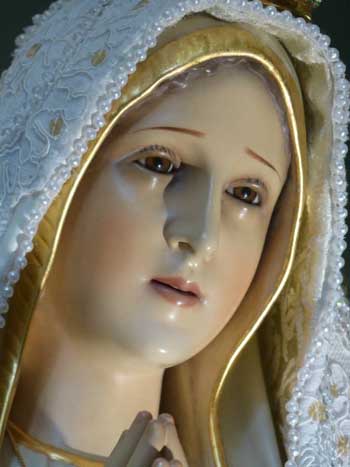
A prelude to the warning of a chastisement made by Our Lady at Fatima in 1917
Pope Pius IX approved the Lourdes apparition and promoted Marian piety in Lourdes with the granting of special indulgences and the formation of local Lourdes associations. Pope Leo XIII crowned Our Lady of La Salette and issued the apostolic letter
Parte humanae generi in commemoration of the consecration of the new Cathedral in Lourdes in 1879. (2)
St. Bernadette received secrets from Our Lady of Lourdes that she kept to her death on April 16, 1879. Four months later in 1879, we have the silent apparition of Knock. The 18th and last apparition of Our Lady in Lourdes was July 16, the feast of Our Lady of Mount Carmel. At the last apparition in Fatima on, October 13, 1917, Our Lady appeared as Our Lady of Mount Carmel.
La Salette told us in 1846 that “the Church will be in eclipse.” At Lourdes in 1858, Bernadette wept saying: “Penance! Penance! Penance!” At Fatima in 1917 she spoke of a coming “chastisement such as the world has never seen.”
So, I ask, what should we understand as the message of the dark, rainy, silent apparition at Knock in 1879 where St. John is preaching from the Apocalypse? After the dire messages of La Salette and Lourdes, is not the Knock apparition a perfect prelude to the threatening message of Fatima? I believe it is. And it is certainly not a message where, as a favorite Lady of Knock song croons , “All my cares and troubles cease.” (3)
An approaching storm
If we look at the four successive apparitions – La Salette (1846), Lourdes (1858), Knock (1879) and Fatima (1917) – it is interesting to notice the increasingly hostile weather conditions of each. At La Salette, the weather was beautiful, a glorious sunny day in the French Alps. But at Lourdes, things began to change.
The first apparition at the grotto of Lourdes began with a sudden gust of wind and the strong sound of something like an approaching storm. The young Bernadette describes what happened as she was about to wade through the shallow stream:
“I had just begun to take off my first stocking when suddenly I heard a great noise like the sound of a storm. I looked to the right, to the left, under the trees of the river, but nothing moved; I thought I was mistaken. I went on taking off my shoes and stockings, then, I heard a fresh noise like the first. I was frightened and stood straight up. … I saw at one of the openings of the rock a rosebush, one only, moving as if it were very windy.” (1)
Despite this threatening beginning, the multiple apparitions of Lourdes were not particularly marked by rain or bad weather.
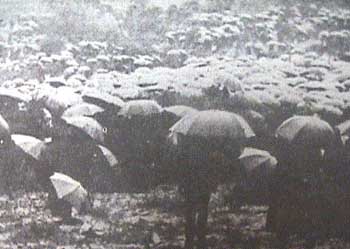
A heavy rain fell on the thousands present at Fatima on October 13, when the miracle of the sun took place
At Knock, as I previously mentioned, the rain became a downpour. But in my readings I found no mention of any lightning or thunder.
At Fatima, all the apparitions were presaged by a type of lightening flash and thunder. And by the last apparition on October 13, 1917 – the apparition for which Our Lady promised a sign – the weather for the week in that part of Europe had been the worst in recent memory.
It was very cold and wet, and the roads became quagmires. Around noon, these meteorological omens culminated in a cosmic event now known as the “miracle of the sun”: The rain stopped, the clouds opened, colored rays dart from the sun, which ‘danced,’ then fell, causing great fear in the crowd. The spectators thought they were going to die. Then, the sun returned to its place in the heavens, and everything, including the muddy ground, became completely dry.
Our Lady of Knock is an apparition replete with symbolism. Even though no words were spoken or written, through symbolism its message and meaning becomes clear. One important message – in the context of the other recent apparitions of Our Lady – is found in the increasingly threatening weather conditions that culminated in a cosmic event.
I believe this is also a symbol that should be understood as part of a dire message that Our Lady wished to convey at Knock. A storm of cosmic proportions – a chastisement from God – is coming!
If we consider the atrocities of the present Papacy, perhaps it has already begun.
Testimony of a Witness, Mary Byrne, recorded by the Knock Commission
“I live in the village of Knock, to the east side of the chapel. Mary McLoughlin came on the evening of the 21st August to my house at about half past seven o’clock. She remained some little time.
I came back with her as she was returning homewards. It was either eight o’clock or a quarter to eight at the time. It was still bright. I had never heard from Miss McLoughlin about the vision, which she had seen just before that.
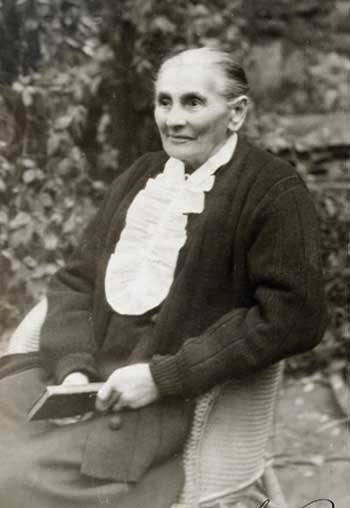 Witness Mary Byrne from the village of KnockThe first I learned of it was on coming at the time just named from my mother’s house in company with Miss Mary McLoughlin, and at the distance of 300 yards or so from the church. I beheld, all at once, standing out from the gable and rather to the west of it, three figures which, on more attentive inspection, appeared to be that of the Blessed Virgin, St. Joseph and St. John. That of the Blessed Virgin was life-size, the others apparently either not so big or not so high as her figure.
Witness Mary Byrne from the village of KnockThe first I learned of it was on coming at the time just named from my mother’s house in company with Miss Mary McLoughlin, and at the distance of 300 yards or so from the church. I beheld, all at once, standing out from the gable and rather to the west of it, three figures which, on more attentive inspection, appeared to be that of the Blessed Virgin, St. Joseph and St. John. That of the Blessed Virgin was life-size, the others apparently either not so big or not so high as her figure.
They stood a little distance out from the gable wall, and, as well as I could judge, a foot and a half or two feet from the ground. The Virgin stood erect, with eyes raised to heaven; her hands elevated to the shoulders or a little higher, the palms inclined slightly towards the shoulders or bosom. She wore a large cloak of a white color, hanging in full folds and somewhat loosely around her shoulders, and fastened to the neck.
She wore a crown on the head, rather a large crown, and it appeared to me somewhat yellower than the dress or robes worn by Our Blessed Lady. In the figure of St. Joseph the head was slightly bent, and inclined towards the Blessed Virgin, as if paying her respect. It represented the saint as somewhat aged, with grey whiskers and greyish hair.
The third figure appeared to be that of St. John the Evangelist. I do not know, only I thought so, except the fact that at one time I saw a statue at the chapel of Lecanvey, near Westport, Co. Mayo, very much resembling the figure which stood now before me in group with St. Joseph and Our Blessed Lady, which I beheld on this occasion.
He held the Book of Gospels, or the Mass Book, open in his left hand, while he stood slightly turned on the left side towards the altar that was over a little from him. I must remark that the statue which I had formerly seen at Lecanvey chapel had no miter on its head, while the figure which now beheld had one, not a high miter, but a short set kind of one. The statue at Lecanvey had a book in the left hand, and the fingers of the right hand raised. The figure before me on this present occasion of which I am speaking had a book in the left hand, as I have stated, and the index finger and the middle finger of the right hand raised, as if he were speaking, and impressing some point forcibly on an audience.
It was this coincidence of figure and pose that made me surmise, for it is only an opinion, that the third figure was that of St. John, the beloved disciple of Our Lord, but I am not in any way sure what saint or character the figure represented. I said, as I now expressed, that it was St. John the Evangelist, and then all the others present said the same – said what I stated.
The altar was under the window, which is in the gable and a little to the west near the center, or a little beyond it. Towards this altar St. John, as I shall call the figure, was looking, while he stood at the Gospel side of the said altar, which his right arm inclined at an angle outwardly, towards the Blessed Virgin.
The altar appeared to be like the altars in use in the Catholic Church, large and full-sized. It had no linens, no candles, nor any special ornamentations; it was only a plain altar.
Above the altar and resting on it was a lamb, standing with its face towards St. John, thus fronting the western sky. I saw no cross or crucifix.
On the body of the lamb and around it, I saw golden stars, or small brilliant lights, glittering like jets or glass balls, reflecting the light of some luminous body. I remained from a quarter past eight to half past nine o’clock. At the time it was raining.”
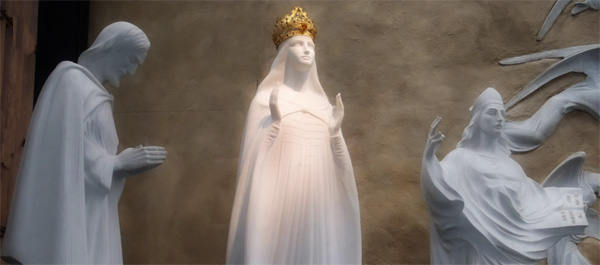
St. Joseph and St. John on either side of Our Lady at Knock
Continued- Bernadette and the Beautiful Lady by Frances Parkinson Keyes; ohn J. Delaney, A Woman Clothed with the Sun NY:Image Book, 1960
- See here
- Chorus of Lady of Knock lyrics by James Kilbane: ”Golden Rose, Queen of Ireland, all my cares and troubles cease, as I kneel with love before you, Lady of Knock, my Queen of Peace”. Official Catholic website of Our Lady of Knock
Posted April 9, 2016
Reflections on Knock - VI
Knock, Mediatrix of All Graces & Immaculate Heart of MaryGregory Johnson
In these reflections on Our Lady of Knock (August 21, 1879), I have been presenting the
symbolism of this silent apparition, and I have shown its connections to the other three recent apparitions of Our Lady: La Salette (1846 -
here and
here),
Lourdes (1858) and
Fatima (1917).
It has been demonstrated that in these apparitions:
- Our Lady appeared to laymen (usually children), never the clergy;
- She did not appear inside Church structures – at Knock she appeared deliberately outside a church;
- These apparitions all contain secrets;
- They all point to a coming dire cosmic event, an approaching storm..
Today, I will briefly present two Marian devotions and their links to the Knock apparition.
The Image of Our Lady at Knock
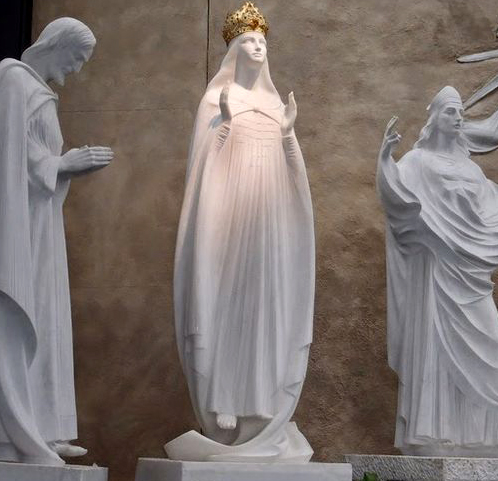
Our Lady, with eyes uplifted & a position of petition
At Knock, Our Lady is described as wearing a white or silvery-white garment with a cloak clasped around the neck, a golden crown with a rose (Rosa Mystica) and topped with sparkling stars or crosses. She appeared outside the church on a slightly higher level than the other figures.
But the most distinguishing feature of Our Lady in this apparition is her gaze and the position of her hands.
In fact, if you spot an image of Our Lady where she is gazing upward and her palms are raised to the level of her heart, a couple of feet apart yet facing one another, you are probably looking at an image of Our Lady of Knock. It is a position of someone who is directing an intense prayer to God.
Our Lady of Knock as mediatrix of all graces
If we consider this apparition in light of the many chaotic, tragic and violent events of the last 137 years, the universal chastisement to come and her triumph foretold at Fatima, I believe we should see Our Lady’s posture at Knock as one of a mother who is praying, petitioning and interceding before God on behalf of her children, the faithful, concerning these coming events.
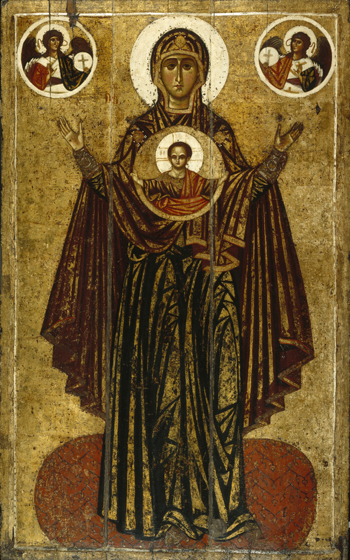
Our Lady as
Orante in an ancient Russian icon
Her pose is that of a Mediatrix, as observed by author Mary Purcell:
“It is interesting to note that none of the witnesses [at Knock] had ever seen a picture or statue showing Our Lady in this attitude, but authorities on Marian art have commented on the similarity between the description of Our Lady by the Knock witnesses and early Christian paintings in the Roman catacombs depicting the Blessed Virgin as Advocate or
Orante, her hands raised in prayer …
“Four witnesses said that she appeared to be praying. When a Queen prays, it is to intercede for her people, to be their advocate, to obtain favors for them. Hence theologians have seen Mary as she appeared at Knock as the mediatrix of all graces.” (1)
I believe that Our Lady as “mediatrix of all graces” will someday be declared an infallible dogma of the Catholic Church. If this is true, then the apparition at Knock can be seen as a presage to the declaration of this dogma.
It is rumored that Pope Pius XII was preparing such a declaration but changed directions and, instead, declared the less Protestant-offensive dogma of the Assumption in 1950. In this period leading up to the catastrophic Vatican II, the lax, liberal, and progressivist forces in the Vatican have been obstinately opposed to such an anti-ecuмenical dogma that would declare Our Lady to be the universal mediatrix of graces.
Knock & Fatima: The Immaculate Heart of Mary
The 19th century was replete with miracles and manifestations of Mary, i.e.: The Miraculous Medal and her apparitions to
St. Catherine Labouré (1830),
Our Lady of the Miracle and her apparition to
Alphonse Ratisbonne (1842), the finding of the 1712 manuscript
True Devotion to Mary written by the Apostle of Mary
St. Louis de Montfort (1842),
Our Lady of La Salette (1846),
Our Lady of Lourdes (1858), the declaration of the dogma of the Immaculate Conception (1854) and many other actions of Pius IX promoting Our Lady.
More specifically, devotion to the Heart of Mary grew tremendously during the 1800s:
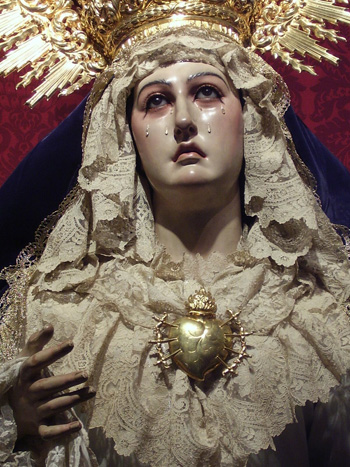
The Feast of the Immaculate Heart of Mary on August 22, one day after the Knock apparition
“In 1799 Pius VI, then in captivity at Florence, granted the Bishop of Palermo the feast of the Most Pure Heart of Mary for some of the churches in his Diocese. In 1805 Pius VII made a new concession, thanks to which the feast was soon widely observed. Such was the existing condition when a two-fold movement, started in Paris, gave fresh impetus to the devotion.
"The two factors of this movement were, first of all, the revelation of the “miraculous medal” in 1830 and all the prodigies that followed and, then, the establishment at Notre-Dame-des Victoires of the Archconfraternity of the Immaculate Heart of Mary, Refuge of Sinners, which spread rapidly throughout the world and was the source of numberless graces.
“On 21, July, 1855, the Congregation of Rites finally approved the Office and Mass of the Most Pure Heart of Mary without, however, imposing them upon the Universal Church. Pope Pius XII instituted the feast of the Immaculate Heart of Mary in 1944 to be celebrated on 22 August, coinciding with the traditional octave day of the Assumption.” (2)
In 1944, when the Feast of the Immaculate Heart was finally proclaimed, the world was in the midst of the unprecedented destruction of the Second World War. Pius XII’s dedication of a feast day to the Immaculate Heart of Mary should be seen as a desperate plea and response to Our Lady’s request at Fatima,“God wishes to establish in the world devotion to My Immaculate Heart” (July 13th apparition).
The new feast day would be celebrated on August 22. As a result, the day of the Apparition of Knock, August 21, which was already within the Octave of the Assumption, August 15, would mark the eve of the Feast of the Immaculate Heart of Mary. Just as the Knock apparition would be followed by the Fatima apparition, so also the feast day of Knock was followed by the feast day of the Immaculate Heart – which Our Lady at Fatima came to establish.
Perhaps it could even be said that at Knock the opening of her hands that are normally folded in front of her Immaculate Heart was a pre-vision of this coming devotion and final triumph of her Immaculate Heart.
Foreseeing changes in the liturgy & miserablism
It is important to note that all the seers at Knock viewed, to the right and in the background, a “plain altar with a lamb standing on it.” They further explained that what they meant by “plain altar" was, “an altar without candlesticks, linens or decorations of any kind.” It was an altar unadorned and bare.
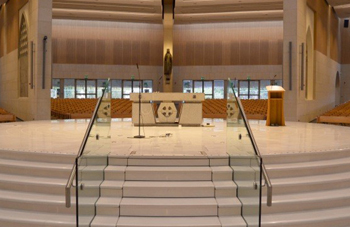
The stripped altar in the new Basilica at Knock
By 1969, in the aftermath of the disastrous Second Vatican Council, “Liturgical Reform” came as a destructive tidal wave. Pope Paul VI moved the Feast of the Immaculate Heart of Mary and changed or eliminated many other Feasts. Sacred, beautiful altars, like the liturgy, were stripped of beautiful ornaments, made plain, tossed out, desecrated and destroyed.
So, with this in mind, I believe that the presence of the “plain altar” in the Knock apparition was a prophetic allusion to this coming miserablist destruction of Vatican II.
I pause here to present the words of Bridget Trench, who is considered one of the most interesting of the 15 Knock testimonies.
Testimony of Bridget Trench, witness before the Knock Commission
“My name is Bridget Trench; I live near the Chapel at Knock. About half past seven o’clock on the night of the 21st of August, I was in the house of Mrs. Campbell, which was quite near to the Chapel. While I was there Mary Byrne came in and said there was a sight to be seen at the Chapel such as we never before beheld, and she told us all to come and see it. I asked her what it was, and she said that the Blessed Virgin, St. Joseph and St. John were to be seen there.
"I went out immediately and went to the spot indicated. When I arrived there, I saw distinctly the three figures, I threw myself on my knees and exclaimed. “A hundred thousand thanks to God and to the glorious Virgin who has given us this manifestation.” I went in immediately to kiss, as I thought, the feet of the Blessed Virgin, but I felt nothing in the embrace but the wall, and I wondered why I could not feel with my hands the figures which I had so plainly and so distinctly seen.
"The three figures appeared motionless, statue-like, they were standing by the gable of the Church in the background and seemed raised about two feet above the ground. The Blessed Virgin was in the center; she was clothed in white and covered with what appeared one white garment. Her hands were raised to the same position as that in which a priest holds his hands when praying at holy Mass. I remarked distinctly the lower portions of her feet, and kissed them three times. She had on her head something resembling a crown and her eyes turned up heavenwards.
"I was so taken with the Blessed Virgin that I did not pay much attention to any other, yet I saw also the two other figures: St. Joseph standing to the right of the Blessed Virgin, or to the left as I looked at him, his head bent towards her and his hands joined; and the other figure, which I took to be St. John the Evangelist, was standing at her left. I heard those around me say that the image was St. John.
"It was raining very heavily at the time, but no rain fell where the figures were. I felt the ground carefully with my hands and it was perfectly dry. The wind was blowing from the south, right against the gable of the Chapel, but no rain fell on that portion of the gable or Chapel in which the figures were.
"There was no movement or active sign of life about the figures, and I could not say whether they were what living beings would in their place appear to be or not, but they appeared to me so full and so lifelike and so life-size that I could not understand why I could not feel them with my hands such as I beheld them with my eyes.
"There was an extraordinary brightness about the whole gable of the chapel, and it was observed by several who were passing along the road at the time. I remained there altogether about an hour and when I came there first I thought I would never leave it. I would not have gone as soon as I did, but that I considered that the figures and the brightness would continue there always and that on coming back I would again behold them.
"I continued to repeat the rosary on my beads while there and I felt great delight and pleasure in looking at the Blessed Virgin. I could think of nothing else while there but giving thanks to God repeating my prayers.” Continued- Mary Purcell, A Woman Clothed with the Sun, New York: Image Books, Doubleday, 1960, p. 170
- Immaculate Heart of Mary – Wikipedia
Posted July 13, 2016
Reflections on Knock - VII
St. John in the Apparition of Knock
Gregory Johnson
In the sequence of this series, let us analyze today the figure of St. John the Apostle in the scene at Knock. The figure of St. John is perhaps the most interesting aspect of the Knock apparition.
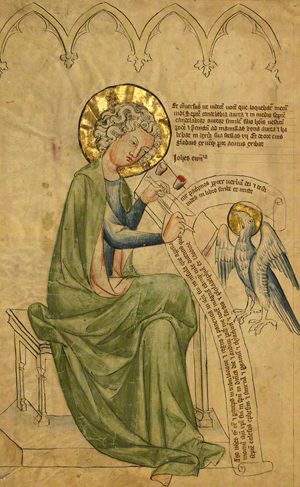
A medieval manuscript depicting St. John writing the Apocalypse
Indeed, it was the presence, pose and symbolism of St. John that first drew me to further study the message of Knock. Before entering the subject of St. John’s presence at Knock, allow me to present a few details concerning this special Apostle.
St. John was the youngest of the 12 Apostles. He was a virgin and because of his virtue and purity, he was often referred to in the Bible as “the disciple whom Jesus loved.” He was the one to whom Our Lady was entrusted by Our Lord himself from the height of the Cross. He was the only Apostle who did not flee, but was present at the foot of the Cross.
He wrote three small Epistles and was an Apostle who penned one of the four Gospels – hence the title “St. John the Evangelist.” He also wrote the last book of the Bible, which is the mysterious and prophetic book of the Apocalypse; hence another title, “St. John of the Apocalypse.”
Along with St. Peter and St. James, St. John was present at the Transfiguration on Mt. Tabor, the Garden of Gethsemane and most of the other significant events of Our Lord’s life.
Our Lady, St. Joseph & ‘a Bishop’
At the Knock apparition, the figure of Our Lady was immediately recognized by the witnesses and required no verbal or written proof. She appeared in the front and center, a little taller than the other two figures and was clearly the focal point of the apparition.
St. Joseph also was immediately recognized by every witnesses of that mystical phenomenon. Indeed, St. Joseph is always one of the easier figures to recognize in any Church. He usually appears tall and lean, holding a lily-flowered or plain staff and often the Child Jesus. He is normally groomed and attired as a grown man of apostolic times, markedly older than Our Lord and the Apostles. The grey coloring of his beard in the apparition at Knock was spoken of by at least two witnesses. As one of the female witnesses adroitly put it, “Everyone knows what St. Joseph looks like.”
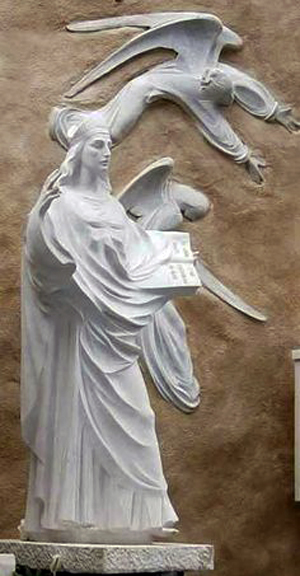
The statue of the mitered St. John at Knock
However, the identity of the third figure, St. John, was not so easily recognized and he was, at first sight, referred to simply as “a Bishop” because of the miter on his head. The simple peasants of Knock came to realize that the “Bishop” was St. John the Apostle through conversations during the apparition. One of the witnesses had recently been to the city of Lecanvey where she had seen a statue of St. John very similar to the third figure in the apparition.
Ever since the Knock apparition in 1879, the “Bishop” has been universally recognized as St. John, who was, in fact, the Bishop of Ephesus. This is because the third figure corresponds to the traditional representations of St. John who is always depicted as a young man with no beard, long hair and wearing the clothing of apostolic times. Also, the presence of the “Lamb of God” on the altar is a strong proof of the identity of this “Bishop.”
St. John, indeed, is the only one in Sacred Scripture to use the expression, “Lamb of God,” which was first used in the first chapter of St. John’s Gospel. St. John reports that this expression was used by St. John the Baptist when he saw Our Lord approaching: “The next day, John [the Baptist] saw Jesus coming to him, and he saith: Behold the Lamb of God, behold him who taketh away the sin of the world” (John 1:29). And, also, “And beholding Jesus walking, he saith: Behold the Lamb of God.” (John 1:36).
It is also interesting to note that the apparition of Knock took place outside St. John the Baptist Church. The use of the word “Lamb” with a capital L, which refers to Our Lord, appears many times in St. John’s Apocalypse. But, let us discuss this in another article.
To my knowledge, this is the only public apparition of St. John. But even if it is not, his appearance can be categorized as apocalyptic. In either case, the message of Knock might be clarified if we find answers to these questions:
- Why did he appear in 1879? What was happening or about to happen in the spiritual sphere, the Church, and the temporal sphere, the State?
- Why was St. John dressed as a Bishop and preaching from an open book (probably his own), appearing after the forced temporary suspension of the First Vatican Council (1871) and before the final threatening apparition at Fatima (1917)?
- It is not the custom to depict Apostles wearing a Bishop’s miter. Usually they are represented with the tongue of fire from the Pentecost, a halo, or nothing on their head but holding an identifying symbol such as keys, a sword, etc. Why this unusual depiction of St. John as Bishop of Ephesus?
I believe that St. John’s presence at Knock, with the special emphasis placed on his bishopric is something too unique and too unusual to not have something to do with Our Lady’s message at Knock. If we consider the en masse apostasy, betrayal and silence of the present-day Bishops, including the Bishop of Rome, the appearance of the Bishop St. John becomes even more significant… even critical.
Is the presence of Bishop St. John in a “living tableau” in Knock in 1879 an indication of the future presence of Bishop St. John living in our own time?
In my next article I shall discuss this possibility.
Testimony of Dominick Byrne (Senior), one of the 15 official witnesses
“I live in Knock, I remember the night of the 21st of August, my cousin Dominick Byrne, came to see us at about 8 o’clock p.m. and called me to see the vision of the Blessed Virgin Mary and other saints at the south gable of the chapel.
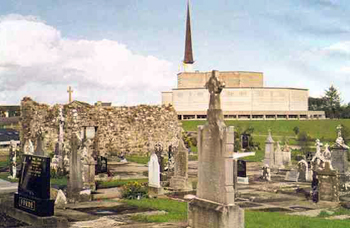 The cemetery at knock where most of the witnesses are buriedI went with him. When I reached the south side of the chapel, we saw the image of the Blessed Virgin Mary, having her hands uplifted and her eyes turned up towards heaven, as if in prayer and she was dressed in a white cloak.
The cemetery at knock where most of the witnesses are buriedI went with him. When I reached the south side of the chapel, we saw the image of the Blessed Virgin Mary, having her hands uplifted and her eyes turned up towards heaven, as if in prayer and she was dressed in a white cloak.
To her right I saw St. Joseph, and on her left St. John, just as the other persons had told me before I came.
I saw an altar there and figures representing saints and angels traced or carved on the lower part of it. The night was dark and raining, and yet these images in the dark night appeared with bright lights as plain as under the noonday sun.
At the time it was pitch dark and raining heavily, and yet there was not one drop of rain near the images.
There was a miter on St. John’s head, nearly like that which a bishop wears. I was there for only one quarter of an hour. At the time I was there, five other persons were in it with me, looking at it with me, looking on at the Apparition. All the figures appeared clothed in white. The whiskers on St. Joseph were an iron grey. The Blessed Virgin had on a white cloak.
The reason I had for calling the third figure St. John is because some saw his statue or his likeness at Lecanvey parish chapel. Reflections on Knock - XI
Knock Message Hidden & Defiled
by Vatican II Hierarchy
Gregory Johnson
I believe that the Vatican II Hierarchy is presenting Our Lady’s message in a way opposed to the truth. In fact, they are using the
silent apparition at Knock to promote Progressivism, false religions and the new morality. The evidence I will present is from a 39-minute film entitled
The Story of Knock.
A biased message of Knock
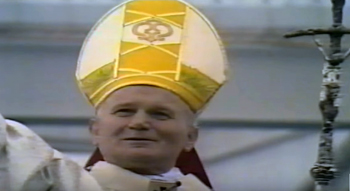
JPII, celebrating joy and peace at Knock, ignores any dire warning
In 1988, a promotional film called
The Story of Knock was produced after Pope John Paul II’s visit to the Knock Shrine in 1979 – the celebration of the centenary of the apparition [34:47 minute mark]. This film has become the most widely known professional film concerning the apparition of Knock and its Shrine. It can be found free online.
The Story of Knock features footage of the Knock Shrine grounds and ceremonies and interviews from the highest ranking clergy involved with Knock. It is a clear demonstration of how the Vatican II Hierarchy wishes to present Knock and its meaning to the public.
Lulled to sleep at Knock
Throughout the film we hear repeatedly the chorus of
Lady of Knock, a song written in 1981 that has become something akin to the official theme song for the Knock apparition.
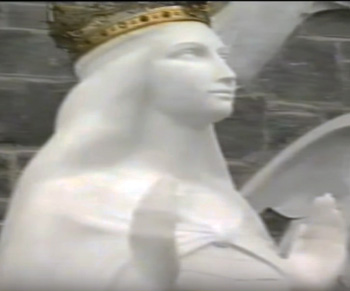
Lulled into a sweet sleep with the lyrics of Our Lady of Knock, Queen of Peace
Golden Rose, Queen of Ireland,
All my cares and troubles cease,
As I kneel with love before thee.
Lady of Knock, our Queen of Peace. It has a peaceful, lullaby-like melody with lyrics that lead its listeners to think of peace and to be without cares and trouble-free. But, in light of the grave crisis of the Church in 1988 (recall John Paul II’s 1986 pan-religious gathering at Assisi), this is the opposite of the
Knock message so strongly tied to La Salette where Our Lady wept incessantly, warning us of an approaching chastisement due to a corrupt and filthy Hierarchy and world. There she said outright that “Rome will lose the Faith.”
It is wrong to be indifferent to the tears, burdens and concerns of Our Lady. As Catholics do we not pray that our hearts be like unto hers? Wise and Immaculate Heart of Mary, Make my heart like unto thine (
Cor Sapientiale et Immaculatum Mariae, fac cor meum secundum cor tuum). If we add the portending message of Fatima, there is even greater reason to be heedful. As a matter of fact, times of the greatest concern are often accompanied by a very profound silence.
As I mentioned before, the
silence of Our Lady at Knock must not be construed as a message of “peace” where “cares and troubles cease.”
World Youth Day morals & attire
In many places this video presents the casual, immodest, inappropriate and disrespectful attire that has become common place among lay people in the post-Vatican II epoch.
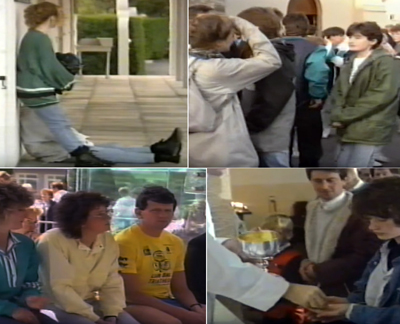
The bad WYD customs & vulgar dresses are present at Knock
Even in the presence of the Blessed Sacrament, we see the visitors of Our Lady’s Shrine wearing shorts, T-shirts, jeans, women wearing pants, casual and extravagant cloths [7:45]. If we consider that this film was made about 30 years ago, then, it should be seen as a beginning of the current amoral World Youth Day style.
Besides the shabby attire, the video is replete with
Novus Ordo Masses, concelebrated Masses [24:02], Communion in the Hand [30:22], Guitar Masses [18:08] and other novelties of Vatican II ceremonies [4:42].
Progressivist social justice
At the 18:54 minute mark, the pastor of the Knock Shrine says:
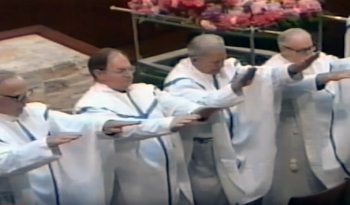
Priests concelebrating at the Knock shrine
“And the Christian family in 1988 needs to be an involved family; it needs to be involved in the life of the local community. In issues of social justice that arise on its own doorstep; in the missionary effort of the Church; in the elementary and uneven battle between life and death that goes on daily in the Third World. Every Christian family should have a social, even international dimension.”
By 1988, ”social justice” had already become a synonym for Liberation Theology and other socialist/communist agendas, especially in the Third World. We who live in 2017 are witnessing 30 years later the dire consequences of this so-called social justice that exploded with Vatican II and has fallen to unimaginable depths in the reign of Pope Francis.
Insufficient truths presented as the Knock message
The film makes feeble attempts at explaining the apparition at Knock, presenting simple things that are common knowledge to the Faithful:
- “Mary’s coming gave them hope” (the people of Ireland in 1879). [7:30]
- “Two of the witnesses testified that Mary wore a crown on her head… she is mother and intercessor.” [8:14]
- “With the passage of years, the richness of the apparition becomes clearer. Mary is the Mother of God. Her message is a silent one. Namely, that she is present with souls who suffer now as she was with Jesus on Calvary and with the people of Knock and their privations in 1879.” [22:41]
- “St. Joseph is the support of Mary and patron of family life.” [23:07]
- “John holds open a Bible and preaches from it. With this gesture John is inviting us to study the word of God.” [23:45] It is interesting to note that the identity of the book is uncertain since it could be just the Apocalypse and not the entire Bible. Notwithstanding, the message is being used to spread “bible studies,” which are a common practice of Protestants.”
Would Our Lady appear just to repeat what the faithful already know and have known since the beginning of the Church? Apparitions of Our Lady are far too rare to not have a purpose. So, the statements listed above, even though they are true, cannot be the reason Our Lady appeared at Knock.
Defiling the Knock message through ecuмenism & pacifism
Ecuмenism is openly promoted at the Knock Shrine. In the spirit of Vatican II, the Faith is subjected to a dishonorable relativism where peace is sought at any cost:

The Knock priest,
at left in red, welcomes leaders of false religions
“Pilgrims from all walks of life come to Knock to pray for peace. At Our Lady’s shrine the quest for peace takes many forms. As the Shrine develops, an increasing number of people are beginning to see Our Lady’s Shrine as a center, not just for personal or family peace, but also for universal peace; a place where individuals, groups and entire communities come together independent of social or religious divide.”
The pastor of Knock, Msgr. Dominic Greely, publicly welcomes Protestant ministers. Then, the Protestant preachers pray and speak to the Catholics gathered at the Knock Shrine. We are told: "Ever conscious of the need to cater to all Christians, Knock Shrine is working hard to foster an ecuмenical spirit and ecuмenical services are encouraged." [15:30]
This official promotion of heretics, schismatics and other false religions at the Shrine is a disgraceful, sacrilegious defilement of Our Lady’s apparition and an affront to the messages of Knock, La Salette, Lourdes and Fatima.
No mention of the Apocalypse
It is well known that St. John, who appears in the Knock apparition, wrote the
Apocalypse - the prophetic book of the New Testament that speaks of future, “things which must shortly come to pass.” (Apoc. 1:1)
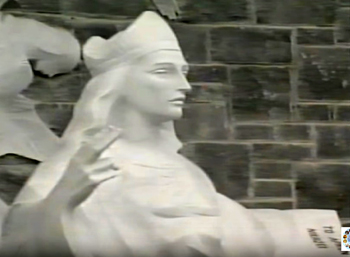
No mention of the book St. John as Bishop holds - the
ApocalypseYet, in the film, the word
Apocalypse is not spoken, not even once. It is safe to say that it is deliberately avoided. At the 23:15 minute mark, St. John is simply described as the “writer of the fourth Gospel and of three of the letters of the New Testament,” nothing more.
So, here we have the astonishing fact that a promotional film about Knock, produced by the Catholic Hierarchy and with its full cooperation, avoids mentioning his prophetic book. The shocking absence of any mention of the
Apocalypse demonstrates, I believe, a deliberate intent to avoid a serious investigation of the true message Our Lady gave at Knock. It seems as if panic is raised at the mere thought of linking Our Lady’s apparition with anything concerning the
Apocalypse. Testimony of John Curry (age 5), one of the 15 official witnesses
The child says he saw images, beautiful images, the Blessed Virgin and St. Joseph.
He could state no more than that he saw the fine images and the light, and heard the people talk of them, and climbed the wall to see the nice things and the lights.